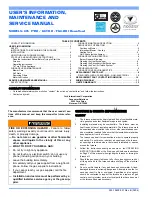
5
CAUTION
Return air grilles and warm air registers must not be
obstructed.
WARNING
When ducting supplies air to a space other than where
the furnace is located, the return air ducts must be
sealed and also be directed to the space other than
where the furnace is located. Incorrect ductwork
termination and sealing will create a hazardous
condition which can lead to bodily harm.
2.2.3
Venting instructions
Venting of the furnace should be to the outside, in
accordance with local codes and other authorities having
jurisdiction.
OIL FIRED APPLIANCES SHALL BE CONNECTED TO
FLUES HAVING SUFFICIENT DRAFT AT ALL TIMES TO
ENSURE SAFE AND PROPER OPERATION OF THE
APPLIANCE.
For additional venting information refer to ANSI/NFPA 211
Chimneys, Fireplaces, Vents and Solid Fuel Burning
Appliances and/or CSA B139 Installation Code.
This furnace is certified for use with an “L” type vent;
maximum flue gas temperature 302°C (575°F).
Pre-Installation Vent System Inspection
Before this furnace is installed, it is strongly recommended
that any existing vent system be completely inspected.
For any chimney or vent, this should include the following:
a. Inspection for any deterioration of the chimney or vent.
If deterioration is discovered, the chimney must be
repaired or the vent must be replaced;
b. Inspection to ascertain that the vent system is clear and
free of obstructions. Any blockages must be cleared
before installing this furnace;
c.
Cleaning the chimney or vent if previously used for
venting a solid fuel burning appliance or fireplace;
d. Confirming that all unused chimney or vent connections
are properly sealed;
e. Verification that the chimney is properly lined and sized
per the applicable codes. (Refer to list of codes in
Section 1.)
Masonry Chimneys
This furnace can be vented into an existing masonry
chimney. It must not be vented into a chimney servicing a
solid fuel burning appliance. Before venting this furnace into
a chimney, the chimney must be checked for deterioration
and repaired if necessary. The chimney must be properly
lined and sized per local and/or national codes.
If the furnace is vented into a common chimney, the chimney
must be of sufficient area to accommodate the total flue
products of all appliances vented into the chimney.
The following requirements are provided for a safe venting
system:
a. Ensure that the chimney flue is clear of any dirt or
debris;
b. Ensure that the chimney is not servicing an open
fireplace;
c.
The flue pipe can be 13 to 15 cm (5 or 6") in diameter
respectively;
d. All pipes are supported using the proper clamps and/or
straps. These supports should be installed at least
every 1.2 m (4');
e. All horizontal runs of pipe should have a slope of at
least 2 cm per 1 m (¼” per foot);
f.
All runs of pipe should be as short as possible with as
few turns as possible;
g. Seams should be tightly joined and checked for leaks;
h. The flue pipe must not extend into the chimney but be
flush with the inside wall;
i.
The chimney must extend 0.9 m (3') above the highest
point where it passes through a roof of a building and at
least 0.6 m (2') higher than any portion of a building
within a horizontal distance of 3 m (10'). It shall also be
extended at lest 1.5 m (5') above the highest connected
equipment flue collar;
j.
Check local codes for any variances.
Factory Built Chimneys
The furnace may be used with an approved factory built
chimney. Refer to chimney manufacturer’s instructions for
proper installation.
2.2.4
Oil burner
This furnace is supplied with a high pressure atomizing
retention head type burner, for use with not heavier than
grade 2 Fuel Oil. The burner model is a Beckett AFG, the
mounting flange is fixed to the burner air tube and no
adjustment is required for insertion length.
CAUTION
NEVER use the ”interrupted ignition” function if a
Honeywell R7184 series combustion relay is installed on
the burner.
Oil Connections
Complete instructions for installation of the fuel oil piping will
be found in the oil burner installation instructions included
with the furnace.
Openings for the oil line have been machined on the side
panels. Two holes are provided in each location, so that a
two-pipe system may be installed if desired.
A 10 (or less) micron oil filter should be used with all oil
burners and installed as closely as possible to the burner.
Barometric Draft Control
A barometric draft control must be used with the furnace to
ensure proper operation. Installation instructions are
supplied with the control.
Summary of Contents for LOW-BOY AME15-79
Page 16: ...16 Figure 5 D montage du tiroir d l ment...
Page 17: ...17 Figure 6 Diagramme lectrique...
Page 18: ...18 Figure 7 Liste de pi ces B50047 Rev A...
Page 35: ...15 Figure 5 Element drawer removal...
Page 36: ...16 Figure 6 Electrical Diagram...
Page 37: ...17 Figure 7 Parts List B50047 Rev A...
Page 40: ...20...
















































